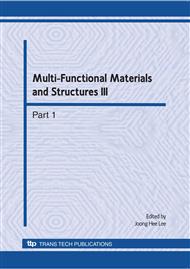p.1123
p.1127
p.1131
p.1135
p.1139
p.1143
p.1147
p.1151
p.1155
Effects of Weave Type and Fiber Content on Physical Properties of Sisal Fiber/Epoxy Composites
Abstract:
In this study, the effects of weave type and fiber content on the physical properties of woven sisal fiber/epoxy composites were investigated. Sisal fibers used in this work were obtained from Nakhon Ratchasima, Thailand. Both untreated and alkali-treated fibers were employed. The woven sisal fibers were manufactured by hand weaving process. The fiber content in sisal fiber/epoxy composites were 3 wt.%, 5 wt.% and 10 wt.%. The composites were cured at room temperatures. In order to determine mechanical properties of the composites, flexural and impact tests were applied. Flexural strength and flexural modulus of all composites were higher than those of pure epoxy resin and tended to increase with increasing fiber content. The impact strength of all composites was lower than that of pure epoxy resin. The composites containing 10 wt.% sisal fibers showed the highest impact strength. There was no definite influence of weave type on flexural properties of the composites. At 3 and 5 wt.% fiber, the composites containing plain weave fibers seemed to show a higher impact strength than the composites containing other weave types.
Info:
Periodical:
Pages:
1139-1142
Citation:
Online since:
August 2010
Authors:
Keywords:
Price:
Сopyright:
© 2010 Trans Tech Publications Ltd. All Rights Reserved
Share:
Citation:


